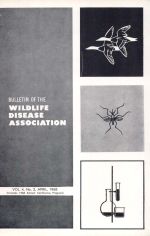Data on brucellosis in several Alaskan caribou herds during 1962–65 is summarized. During this time agglutination-reactor prevalence rates (1:20 or higher) gradually declined in the Nelchina (6.5 percent to 1.0 percent) and Arctic (30 percent to 12 percent) caribou herds. A simultaneous decline (5 percent to 3.4 percent) in the prevalence of placental retention and/or excessive bleeding at parturition was also observed on the Arctic calving grounds in northwest Alaska in 1963 and 1965. Various additional conditions have been observed, from each of which brucella organisms were isolated on several occasions. These include orchitis-epididymitis, bursitis-synovitis and metritis, singly or in combination. In some cases, the observed lesions no doubt resulted in one or more of the following signs: sterility, lameness, and/or abortion with (probable) subsequent death of the female following putrefaction of retained placental structures. During 1963 about 25 percent of 107 cows showing placental retention and/or “excessive bleeding” were unaccompanied by calves when seen a few days post-partum.
The Russian and American points of view regarding naming the causative organism of rangiferine brucellosis are briefly reviewed. Brucella suis biotype rangiferi is proposed as a compromise, based on both the principles of bacterial taxonomy and the natural ecology of the organism.





